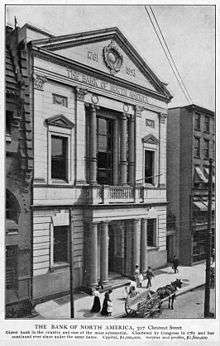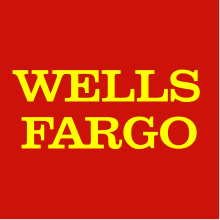Bank of North America
 | |
Formerly | The President, Directors, and Company of the Bank of North America |
|---|---|
| Public | |
| Industry | Financial institution |
| Fate | Merger |
| Successor | Wells Fargo |
| Founded | December 31, 1781 in Philadelphia, Pennsylvania |
| Founders | the Congress of the Confederation of the United States |
| Defunct | 1929 |
| Headquarters | Philadelphia, Pennsylvania, United States |
Area served | Colonial America |
Key people | Tench Francis, Jr., First cashier; later known as the CEO |
The President, Directors, and Company, of the Bank of North America, commonly known as the Bank of North America, was a private bank first adopted on May 26, 1781 by the Confederation Congress,[1] chartered on December 31, 1781[2] and opened in Philadelphia on January 7, 1782.[3][4] It was based upon a plan presented by US Superintendent of Finance Robert Morris on May 17, 1781[5] that created the Nation's first de facto central bank.[6] When shares in the bank were sold to the public, the Bank of North America became the country's first initial public offering.[7] It was succeeded in its role as central bank by the First Bank of the United States in 1791.
History
Congressional charter
-Pennsylvania-6_Aug_1789.jpg)
In May 1781 Alexander Hamilton revealed that he had recommended Morris for the position the previous summer when the constitution of the executive was being solidified. Second, he proceeded to lay out a proposal for a national bank. Morris, who had corresponded with Hamilton previously on the subject of funding the war, immediately drafted a legislative proposal based on Hamilton's suggestion and submitted it to the Congress. Morris persuaded Congress to charter the Bank of North America, the first private commercial bank in the United States.[9]
1782 Inauguration
When Robert Morris became superintendent of finance in February 1781,[10] continental currency had ceased to be issued. On April 30, 1781, Alexander Hamilton sent Morris a letter. The original charter called for the disbursement of 1,000 shares priced at $400 each.[11] Benjamin Franklin purchased one share for 0.1% ownership as a sign of good faith to Federalists and the new bank and Hamilton made public endorsement of the establishment under his pseudonym.[12]
Public offering
William Bingham's first daughter, Ann Louisa Baring, was born the day before the bank opened, and her father purchased 9.5% of the shares for himself. She was also the granddaughter of Thomas Willing, a primary shareholder and the original President of the bank offices at Philadelphia. Using a gift/loan from France, Robert Morris purchased 63.3% of the original shares for the government.[13] Robert Morris deposited large quantities of gold and silver coin and bills of exchange obtained through loans from the Netherlands and France. He then issued new paper currency backed by this supply.
By 1783, Congress and several states including Massachusetts enacted legislation, allowing Americans to pay taxes with Bank of North America certificates.[14] Within three years, the Bank was considered a creditworthy institution.
Bank of Pennsylvania
After a change of party in Pennsylvania's legislature in 1786 the Bank of North America was re-chartered within the Commonwealth in 1787, but under more restrictive conditions that would hinder it from performing its intended role as a central bank.[15] Thomas Willing was appointed its first president on November 2, 1781 (starting when operations began on January 7, 1782) until he was appointed to the First Bank of the United States as one of its original three commissioners on March 19, 1791 (before his later election as its first president on October 25, 1791).
John Nixon was the first director of the Bank of Pennsylvania. Morris subscribed £10,000 sterling to fund it. It was not a bank in the ordinary sense but an organization formed for the purpose of financing supplies for the army. In 1782, the Bank of North America superseded the Bank of Pennsylvania.[16] Serving from 1792 to 1808, Nixon succeeded the first president of the Bank of North America, Thomas Willing, who went on to become the first president of the First Bank of the United States. Nixon was in turn succeeded by John Morton, who served as President until 1822. William Frederick Havemeyer was its president from 1851 to 1861 and brought it successfully through the crisis of 1857. After it had become a National Bank in 1865, a president of the same name presided over its liquidation in 1908.[17]
The Bank of Pennsylvania was re-established in 1793, with a charter from the Commonwealth of Pennsylvania, and branches were opened in Pittsburgh, Harrisburg, Lancaster, Reading, and Easton.[18] The original branch of the Bank of Pennsylvania remained in business in Pennsylvania through the 19th and 20th centuries under a variety of other names including First Pennsylvania Bank and, before its acquisition by Wells Fargo, as Wachovia, First Union Bank and CoreStates. Wachovia (as of November, 2012) operated a branch at the northwest corner of S. 6th and Chestnut Sts. in Philadelphia, diagonally opposite Independence Hall, which was the original site of the Bank of North America.[3] This branch is the longest continuously operating branch bank in the States, operating in that location since 1781.[19] Following Wells Fargo's acquisition of Wachovia, Wells Fargo adopted Charter #1.[20]
Precedence
The Bank of North America along with the First Bank of the United States and the Bank of New York were the first shares traded on the New York Stock Exchange. The Bank of North America opened a Canadian affiliate in Montreal, Lower Canada on March 8, 1837.[21]
See also
References
- ↑ Lewis Jr., Lawrence (1882). 'A History of the Bank of North America, the First Bank Chartered in the United States'. J. B. Lippincott & Co. p. 28.
- ↑ Lewis Jr., Lawrence (1882). 'A History of the Bank of North America, the First Bank Chartered in the United States'. J. B. Lippincott & Co. p. 35.
- 1 2 Robert F. Smith. "Bank of North America". Encyclopedia of Greater Philadelphia. Retrieved 17 March 2016.
- ↑ Michener, John H. (1906). "The Bank of North America, Philadelphia, a national bank, founded 1781; the story of its progress through the last quarter of a century, 1881–1906". New York: R.G. Cooke, Inc.: 37. HG21613.P54. Retrieved 17 March 2016.
- ↑ Continental Congress of the United States (1912). "Establishing a National Bank". Journals of the Continental Congress. U.S. Government Printing Office. 20: 546–549. Retrieved 17 March 2016.
- ↑ Markham, Jerry W. (2002). A Financial History of the United States. Armonk, NY: M.E. Sharpe. p. 87. ISBN 9780765607300. Retrieved 17 March 2016.
- ↑ http://www.moaf.org/exhibits/americas_first_ipo/index
- ↑ Newman, Eric P. (28 November 2008). Early Paper Money of America (5th ed.). Iola, Wisconsin: KP Books. p. 364. ISBN 978-0896893269.
- ↑ Knox, John Jay (1900). Rhodes, Bradford; Youngman, Elmer Haskell, eds. A History of Banking in the United States. B. Rhodes & Company. p. 40. Retrieved 17 March 2016.
- ↑ Bradbury, M.L. (April 1972). "Legal Privilege and the Bank of North America". The Pennsylvania Magazine of History and Biography. The Historical Society of Pennsylvania. 96 (2): 139–66. JSTOR 20090621.
- ↑ Alberts, Robert C. (1969). "The Golden Voyage: The Life and Times of William Bingham, 1752–1804". Houghton-Mifflin: 106. OCLC 563689565. Retrieved 17 March 2016.
- ↑ Hamilton, Alexander; Syrett, Harold Coffin; Cooke, Jacob Ernest (1962). Syrett, Harold Coffin; Cooke, Jacob Ernest, eds. The Papers of Alexander Hamilton. Columbia University Press. ISBN 9780231089050. Retrieved 17 March 2016.
- ↑ Alberts, Robert C. (1969). "The Golden Voyage: The Life and Times of William Bingham, 1752–1804". Houghton-Mifflin. OCLC 563689565. Retrieved 17 March 2016.
- ↑ Alberts, Robert C. (1969). "The Golden Voyage: The Life and Times of William Bingham, 1752–1804". Houghton-Mifflin: 111. OCLC 563689565. Retrieved 17 March 2016.
- ↑ Goddard, Thomas H. (1831). History of Banking Institutions of Europe and the United States. Carvill. pp. 48–50.
- ↑ Kaplan, Edward S. (1999). The Bank of the United States and the American Economy. Greenwood Publishing. pp. 11–12.
- ↑ "Bank of N. America is to liquidate". The New York Times. January 27, 1908.
- ↑ Hoogenboom, Ari; Klein, Philip S. (1973). A History of Pennsylvania (2nd ed.). University Park: Pennsylvania State University Press. p. 223. ISBN 9780271019345. Retrieved 17 March 2016.
- ↑ "The Oldest Bank in America...". Bankers Magazine. Warren, Gorham & Lamont, Incorporated. 103: 149. 1921. Retrieved 17 March 2016.
- ↑ Meng, Henrik (June 14, 2010). "The end of one era and continuation of another". Wells Fargo. Archived from the original on July 20, 2011.
- ↑ Pound, Richard W. (2005). 'Fitzhenry and Whiteside Book of Canadian Facts and Dates'. Fitzhenry and Whiteside. p. 188.
External links
- The Bank of North America, Philadelphia, a National Bank, Founded 1781: The Story of Its Progress through the Last Quarter of a Century, 1881–1906, by Robert Grier Cooke Incorporated (1906).
- Debates and Proceedings of the General Assembly of Pennsylvania, on the Memorials Praying a Repeal of Suspension of the Law Annulling the Charter of the Bank (ed. Mathew Carey, 1786).
- A History of the Bank of North America, the First Bank Chartered in the United States, by Lawrence Lewis, Jr. (J. B. Lippincott & Co. 1882).
- Legislative and Documentary History of the Bank of the United States: Including the Original Bank of North America, by Matthew St. Clair Clarke and David A. Hall. This collection of documents was aimed to include the entire proceedings, debates, and resolutions of Congress relating to the Bank of North America, the First (1791–1811) Bank of the United States, and the Second (1816–1836) Bank of the United States. These documents were compiled four years before the closing of the Second Bank.
- Legislative and Documentary History of the Banks of the United States, from the Time of Establishing the Bank of North America, 1781, to October 1834; with Notes and Comments, by R. K. Moulton. An attempt to compile all the public documents considered to be essential in attaining a thorough knowledge of the national banking operations of the United States, from 1781 to 1834.

